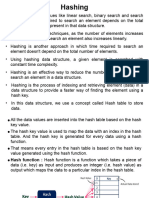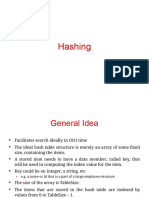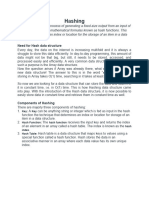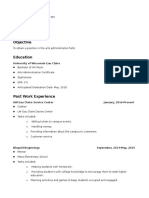0% found this document useful (0 votes)
66 views19 pages9.hash Function and Hash Table
Hashing provides efficient O(1) search time by mapping keys to array indices via hash functions. A good hash function uniformly distributes keys and is efficiently computable. Common hash functions include division, mid-square, digit folding, and multiplication methods. Collisions are resolved via separate chaining by linking keys to the same index, or open addressing by probing to the next open index. Double hashing combines two hash functions to determine probe locations. Elements are inserted by computing the hash code and probing linearly if occupied, and deleted by setting the element to a dummy value.
Uploaded by
Patil VinayakCopyright
© © All Rights Reserved
We take content rights seriously. If you suspect this is your content, claim it here.
Available Formats
Download as PDF, TXT or read online on Scribd
0% found this document useful (0 votes)
66 views19 pages9.hash Function and Hash Table
Hashing provides efficient O(1) search time by mapping keys to array indices via hash functions. A good hash function uniformly distributes keys and is efficiently computable. Common hash functions include division, mid-square, digit folding, and multiplication methods. Collisions are resolved via separate chaining by linking keys to the same index, or open addressing by probing to the next open index. Double hashing combines two hash functions to determine probe locations. Elements are inserted by computing the hash code and probing linearly if occupied, and deleted by setting the element to a dummy value.
Uploaded by
Patil VinayakCopyright
© © All Rights Reserved
We take content rights seriously. If you suspect this is your content, claim it here.
Available Formats
Download as PDF, TXT or read online on Scribd
/ 19


























































































